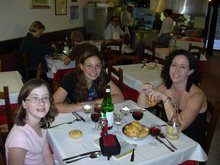
BIBLIOGRAPHY
Peters, Lisa Westberg. 2003. EARTHSHAKE: POEMS FROM THE GROUND UP. Ill. by Cathie Felstead. Greenwillow Books: New York.
This collection of twenty-two poems relating to geology is perfect for science teachers to enrich their curriculum. Poems relating to rocks, lava, quartz, and the continental plates round out this book. This book contains both a table of contents, and of great interest and aid to teachers is the endnote section. The endnote section has notes that correlate to each poem, giving basic geological information that tie into learning the subject. There are a variety of styles of poems in the book, including humorous poems, concrete poems, and poems with plenty of alliteration. Most of the poems are short, and the fact that there is a wide variety of poems will make the book appealing to all students from Kindergarten and up.
Many of the poems will spark an interest in geology, such as:
Recipe for Granite
Melt a chunk of continent.
Heat at a million degrees,
long enough for the world
to spin a trillion times,
long enough for the Milky Way
to make it partway to infinity.
Cool
slowly enough for crystals
to form like pink and white starts,
slowly enough for the dinosaurs
to go extinct.
Makes one mountain range.
Serves a whole country.
Enjoy!
The poem entitled, Plain Old Rock, is a nice introduction to hidden beauty of geodes. Students could learn the poem and see geodes in class.
Plain Old Rock
Plain old rock
by the side of the road.
Should I roll it
into the ditch?
Round rock
by the side of the road.
I pick it up
and feel its weight.
Light rock
by the side of the road.
I take aim with my hammer
and split it.
Geode
by the side of the road.
Gleaming jewels inside.
The illustrations by Cathie Felstead compliment the poems nicely. They are collages created by a variety of materials. Colorful, the illustrations bring the subjects of each poem to life. In the front and back of the book are illustrations which look as if you are seeing inside a rock. Throughout the book, illustrations of acrylics and watercolors help one to see the beauty of the earth through the rich blues, greens, and earthy tones.


